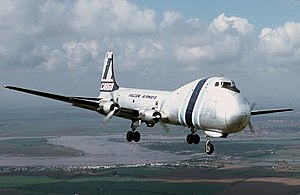Aviation Traders Limited (ATL) was a war-surplus aircraft and spares trader formed in 1947. In 1949, it began maintaining aircraft used by some of Britain's contemporary independent airlines on the Berlin Airlift. In the early 1950s, it branched out into aircraft conversions and manufacturing. During that period it also became a subcontractor for other aircraft manufacturers. By the end of the decade, it was taken over by the Airwork group.

Silver City Airways was an airline based in the United Kingdom that operated mainly in Europe between 1946 and 1962. Unlike many airlines at the time, it was independent of government-owned corporations; its parent company was Zinc Corporation, an Australian company involved mainly in mining and mineral processing. The name "Silver City" originated as a nickname of Broken Hill, Australia – an area famed for silver mines, including some owned by the airline's parent company.

The Douglas DC-8 is an early long-range narrow-body jetliner designed and produced by the American Douglas Aircraft Company. Work began in 1952 towards the United States Air Force's (USAF) requirement for a jet-powered aerial refueling tanker. After losing the USAF's tanker competition to the rival Boeing KC-135 Stratotanker in May 1954, Douglas announced in June 1955 its derived jetliner project marketed to civil operators. In October 1955, Pan Am made the first order along with the competing Boeing 707, and many other airlines soon followed. The first DC-8 was rolled out in Long Beach Airport on April 9, 1958, and flew for the first time on May 30. Following Federal Aviation Administration (FAA) certification in August 1959, the DC-8 entered service with Delta Air Lines on September 18.
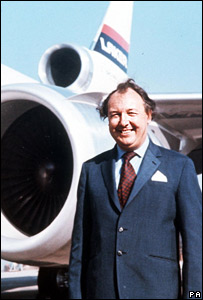
Sir Frederick Alfred Laker was an English airline entrepreneur, best known for founding Laker Airways in 1966, which went bankrupt in 1982. Known as Freddie Laker, he was one of the first airline owners to adopt the "low cost / no-frills" airline business model that has since proven to be successful worldwide when employed by companies such as Ryanair, Southwest Airlines, easyJet, Norwegian Air, and AirAsia.

The Bristol Type 170 Freighter is a British twin-engine aircraft designed and built by the Bristol Aeroplane Company as both a freighter and airliner. Its best known use was as an air ferry to carry cars and their passengers over relatively short distances. A passenger-only version was also produced, known as the Wayfarer.

The Vickers Vanguard was a short/medium-range turboprop airliner designed and produced by the British aircraft manufacturer Vickers-Armstrongs.
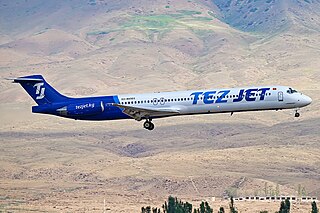
The McDonnell Douglas MD-80 is a series of five-abreast single-aisle airliners developed by McDonnell Douglas. It was produced by the developer company until August 1997 and then by Boeing Commercial Airplanes. The MD-80 was the second generation of the DC-9 family, originally designated as the DC-9-80 and later stylized as the DC-9 Super 80 . Stretched, enlarged wing and powered by higher bypass Pratt & Whitney JT8D-200 engines, the aircraft program was launched in October 1977. The MD-80 made its first flight on October 18, 1979, and was certified on August 25, 1980. The first airliner was delivered to launch customer Swissair on September 13, 1980, which introduced it into service on October 10, 1980.

The McDonnell Douglas MD-11 is an American tri-jet wide-body airliner manufactured by American manufacturer McDonnell Douglas (MDC) and later by Boeing. Following DC-10 development studies, the MD-11 program was launched on December 30, 1986. Assembly of the first prototype began on March 9, 1988. Its maiden flight occurred on January 10, 1990, and it achieved Federal Aviation Administration (FAA) certification on November 8. The first delivery was to Finnair on December 7 and it entered service on December 20, 1990.

On February 15, 1970, a Dominicana de Aviación McDonnell Douglas DC-9 enroute from Santo Domingo, Dominican Republic to San Juan, Puerto Rico crashed into the Caribbean Sea shortly after takeoff. The crash killed all 102 passengers and crew on board, making it the deadliest aviation disaster to occur in the Dominican Republic until 1996 when Birgenair Flight 301 also crashed into the Caribbean Sea, leaving 189 dead.

The Douglas C-54 Skymaster is a four-engined transport aircraft used by the United States Army Air Forces in World War II and the Korean War. Like the Douglas C-47 Skytrain derived from the DC-3, the C-54 Skymaster was derived from a civilian airliner, the Douglas DC-4. Besides transport of cargo, the C-54 also carried presidents, prime ministers, and military staff. Dozens of variants of the C-54 were employed in a wide variety of non-combat roles such as air-sea rescue, scientific and military research, and missile tracking and recovery. During the Berlin Airlift it hauled coal and food supplies to West Berlin. After the Korean War it continued to be used for military and civilian uses by more than 30 countries. It was one of the first aircraft to carry the President of the United States, the first being President Franklin D. Roosevelt during World War II.
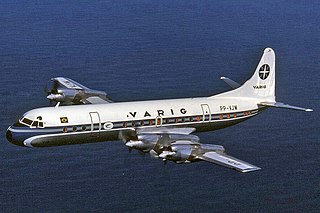
The Lockheed L-188 Electra is an American turboprop airliner built by Lockheed. First flown in 1957, it was the first large turboprop airliner built in the United States. Initial sales were good, but after two fatal crashes that led to expensive modifications to fix a design defect, no more were ordered. With its fairly high power-to-weight ratio, huge propellers and very short wings, large Fowler flaps which significantly increased effective wing area when extended, and four-engined design, the airplane had airfield performance capabilities unmatched by many jet transport aircraft even today—particularly on short runways and high altitude airfields. Jet airliners soon supplanted turboprops for many purposes, and many Electras were modified as freighters. Some Electras are still being used in various roles into the 21st century. The airframe was also used as the basis for the Lockheed P-3 Orion maritime patrol aircraft.
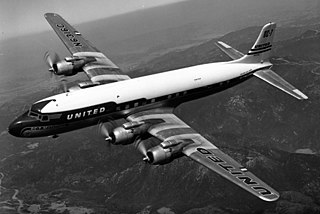
The Douglas DC-7 is an American transport aircraft built by the Douglas Aircraft Company from 1953 to 1958. A derivative of the DC-6, it was the last major piston engine-powered transport made by Douglas, being developed shortly after the earliest jet airliner—the de Havilland Comet—entered service and only a few years before the jet-powered Douglas DC-8 first flew in 1958. Larger numbers of both DC-7B and DC-7C variants were also built.

London Ashford Airport is 1 NM east of the town of Lydd and 12 NM south of Ashford in the district of Folkestone and Hythe, in Kent, England. Originally named Lydd Ferryfield, it is now also known as London Ashford Airport, despite being 60 mi (97 km) from London and over 20 mi (32 km) from Ashford. The airport is closer to France than it is to the city of London.The airport is operated by London Ashford Airport Ltd, controlled by Saudi businessman Fahad Al Athlel.

An air ferry is a ferry service in which cars and passengers are transported by aircraft. Use of air ferries peaked in the 1950s, but the advent of more economical alternative modes of transport in the 1960s resulted in the demise of these services. Today a large part of cross-channel car transport is done through the Channel Tunnel.
British United Air Ferries (BUAF) was a wholly private, British independent car and passenger ferry airline based in the United Kingdom during the 1960s. It specialised in cross-Channel ferry flights carrying cars and their owners between its numerous bases in Southern England, the Channel Islands and Continental Europe. All-passenger and all-cargo flights were operated as well. Following several identity and ownership changes, it went out of business in 2001.

The Canadair North Star is a 1940s Canadian development, for Trans-Canada Air Lines (TCA), of the Douglas DC-4. Instead of radial piston engines used by the Douglas design, Canadair used Rolls-Royce Merlin V12 engines to achieve a higher cruising speed of 325 mph (523 km/h) compared with the 246 mph (396 km/h) of the standard DC-4. Requested by TCA in 1944, the prototype flew on 15 July 1946. The type was used by various airlines and by the Royal Canadian Air Force (RCAF). It proved to be reliable but noisy when in service through the 1950s and into the 1960s. Some examples continued to fly into the 1970s, converted to cargo aircraft.
Air Ferry Limited was a private, independent British airline operating charter, scheduled and all-cargo flights from 1963 to 1968.

Gainesville Municipal Airport is three miles west of Gainesville, in Cooke County, Texas.
Channel Air Bridge was a private British independent airline specialising in cross-Channel vehicle-cum-passenger ferry services. Freddie Laker started Channel Air Bridge as a sister airline of Air Charter on a provisional basis in 1954. Operations commenced in 1955. In 1958, Channel Air Bridge took over Air Charter's vehicle ferry services. In 1959, both Channel Air Bridge and its sister airline Air Charter became part of the Airwork group. In 1960, Airwork joined with Hunting-Clan to form British United Airways (BUA). In 1962, BUA reorganised its vehicle ferry operations by merging Channel Air Bridge with Silver City Airways. This resulted in the creation of British United Air Ferries in 1963.

Air Charter was an early post-World War II private, British independent airline formed in 1947. The airline conducted regular trooping flights to Cyprus as well as worldwide passenger and freight charter flights from its bases at Southend Airport and Stansted. Following Freddie Laker's acquisition of Air Charter in 1951, Aviation Traders and Aviation Traders (Engineering) became associated companies. From 1955, it also operated scheduled coach-air/vehicle ferry services. These initially linked London and Paris. In 1958, the process of transferring Air Charter's coach-air/vehicle ferry operation to sister company Channel Air Bridge began. In 1959, Air Charter became part of the Airwork group. In 1960, Airwork joined with Hunting-Clan to form British United Airways (BUA).
